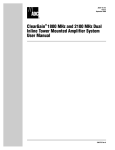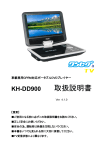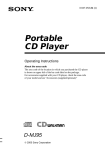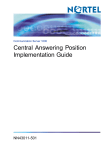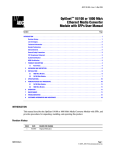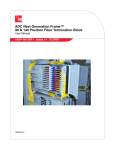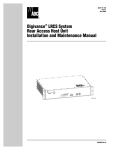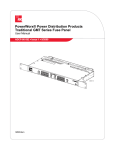Download ADC ClearGain Tower-Mounted Amplifiers User manual
Transcript
ADCP-75-154 Issue 3 August 2006 ClearGain® Tower Mounted Amplifier System 900/1800 MHz User Manual 1379659 Rev A ADCP-75-154 • Issue 3 • August 2006 • Preface COPYRIGHT © 2006, ADC Telecommunications, Inc. All Rights Reserved REVISION HISTORY ISSUE DATE REASON FOR CHANGE 1 06/2003 New publication 2 07/2004 Update drawings 3 08/2006 Add 900 MHz Fullband product LIST OF CHANGES The technical changes incorporated into this issue are listed below. PAGE IDENTIFIER All DESCRIPTION OF CHANGE Update drawings and add 900 MHz specfications. TRADEMARK INFORMATION ADC and ClearGain are registered trademarks of ADC Telecommunications, Inc. DISCLAIMER OF LIABILITY Contents herein are current as of the date of publication. ADC reserves the right to change the contents without prior notice. In no event shall ADC be liable for any damages resulting from loss of data, loss of use, or loss of profits and ADC further disclaims any and all liability for indirect, incidental, special, consequential or other similar damages. This disclaimer of liability applies to all products, publications and services during and after the warranty period. This publication may be verified at any time by contacting ADC’s Technical Assistance Center at 1-800-366-3891, extension 73475 (in U.S.A. or Canada) or 952-917-3475 (outside U.S.A. and Canada), or by e-mail to [email protected]. ADC Telecommunications, Inc. P.O. Box 1101, Minneapolis, Minnesota 55440-1101 In U.S.A. and Canada: 1-800-366-3891 Outside U.S.A. and Canada: (952) 938-8080 Fax: (952) 917-1717 Page ii ADCP-75-154 • Issue 3 • August 2006 • Preface TABLE OF CONTENTS Content Page ABOUT THIS MANUAL . . . . . . . . . . . . . . . . . . . . . . . . . . . . . . . . . . . . . . . . . . . . . . . . . . . . . . . . . . . . . . . . . . . . . . . . . v ADMONISHMENTS . . . . . . . . . . . . . . . . . . . . . . . . . . . . . . . . . . . . . . . . . . . . . . . . . . . . . . . . . . . . . . . . . . . . . . . . . . . v CERTIFICATION . . . . . . . . . . . . . . . . . . . . . . . . . . . . . . . . . . . . . . . . . . . . . . . . . . . . . . . . . . . . . . . . . . . . . . . . . . . . . v STANDARDS . . . . . . . . . . . . . . . . . . . . . . . . . . . . . . . . . . . . . . . . . . . . . . . . . . . . . . . . . . . . . . . . . . . . . . . . . . . . . . . v LIST OF ACRONYMS . . . . . . . . . . . . . . . . . . . . . . . . . . . . . . . . . . . . . . . . . . . . . . . . . . . . . . . . . . . . . . . . . . . . . . . . . . v 1 2 PRODUCT OVERVIEW . . . . . . . . . . . . . . . . . . . . . . . . . . . . . . . . . . . . . . . . . . . . . . . . . . . . . . . . . . . . . . . . . . . . 1 1.1 General Description . . . . . . . . . . . . . . . . . . . . . . . . . . . . . . . . . . . . . . . . . . . . . . . . . . . . . . . . . . . . . . . . 1 1.2 Functional Description . . . . . . . . . . . . . . . . . . . . . . . . . . . . . . . . . . . . . . . . . . . . . . . . . . . . . . . . . . . . . . 2 1.3 MHU Dimensions. . . . . . . . . . . . . . . . . . . . . . . . . . . . . . . . . . . . . . . . . . . . . . . . . . . . . . . . . . . . . . . . . . 3 SYSTEM INSTALLATION . . . . . . . . . . . . . . . . . . . . . . . . . . . . . . . . . . . . . . . . . . . . . . . . . . . . . . . . . . . . . . . . . . . 5 2.1 Installation Overview . . . . . . . . . . . . . . . . . . . . . . . . . . . . . . . . . . . . . . . . . . . . . . . . . . . . . . . . . . . . . . . 5 2.2 Installing the Masthead Unit . . . . . . . . . . . . . . . . . . . . . . . . . . . . . . . . . . . . . . . . . . . . . . . . . . . . . . . . . . 5 2.3 PDU Installation . . . . . . . . . . . . . . . . . . . . . . . . . . . . . . . . . . . . . . . . . . . . . . . . . . . . . . . . . . . . . . . . . . 7 2.4 Bias-T Installation . . . . . . . . . . . . . . . . . . . . . . . . . . . . . . . . . . . . . . . . . . . . . . . . . . . . . . . . . . . . . . . . 11 3 TROUBLESHOOTING . . . . . . . . . . . . . . . . . . . . . . . . . . . . . . . . . . . . . . . . . . . . . . . . . . . . . . . . . . . . . . . . . . . . 11 4 TROUBLESHOOTING 2-PORT CLEARGAIN DUAL DUPLEX TOWER MOUNTED AMPLIFIERS . . . . . . . . . . . . . . . . . . . . . 12 5 6 4.1 Troubleshooting . . . . . . . . . . . . . . . . . . . . . . . . . . . . . . . . . . . . . . . . . . . . . . . . . . . . . . . . . . . . . . . . . 14 4.2 Troubleshooting Hints . . . . . . . . . . . . . . . . . . . . . . . . . . . . . . . . . . . . . . . . . . . . . . . . . . . . . . . . . . . . . 15 MHU SPECIFICATIONS . . . . . . . . . . . . . . . . . . . . . . . . . . . . . . . . . . . . . . . . . . . . . . . . . . . . . . . . . . . . . . . . . . . 16 5.1 DD900 Narrow Band Masthead Unit . . . . . . . . . . . . . . . . . . . . . . . . . . . . . . . . . . . . . . . . . . . . . . . . . . . . 16 5.2 DD900 Full Band Masthead Unit . . . . . . . . . . . . . . . . . . . . . . . . . . . . . . . . . . . . . . . . . . . . . . . . . . . . . . 17 5.3 DD1800 Masthead Unit. . . . . . . . . . . . . . . . . . . . . . . . . . . . . . . . . . . . . . . . . . . . . . . . . . . . . . . . . . . . . 18 CUSTOMER INFORMATION AND ASSISTANCE . . . . . . . . . . . . . . . . . . . . . . . . . . . . . . . . . . . . . . . . . . . . . . . . . . . 19 Page iii © 2006, ADC Telecommunications, Inc. ADCP-75-154 • Issue 3 • August 2006 • Preface Blank Page iv © 2006, ADC Telecommunications, Inc. ADCP-75-154 • Issue 3 • August 2006 • Preface ABOUT THIS MANUAL This document describes the ADC ClearGain 900/1800 MHz tower mounted amplifier system and provides complete instructions for installing this product on a communications tower. ADMONISHMENTS Important safety admonishments are used throughout this manual to warn of possible hazards to persons or equipment. An admonishment identifies a possible hazard and then explains what may happen if the hazard is not avoided. The admonishments — in the form of Dangers, Warnings, and Cautions — must be followed at all times. These warnings are flagged by use of the triangular alert icon (seen below), and are listed in descending order of severity of injury or damage and likelihood of occurrence. Danger: Danger is used to indicate the presence of a hazard that will cause severe personal injury, death, or substantial property damage if the hazard is not avoided. Warning: Warning is used to indicate the presence of a hazard that can cause severe personal injury, death, or substantial property damage if the hazard is not avoided. Caution: Caution is used to indicate the presence of a hazard that will or can cause minor personal injury or property damage if the hazard is not avoided. CERTIFICATION ClearGain 900/1800 MHz has been tested and meets the CE requirements. STANDARDS The following listing is a bibliography of applicable regulatory standards: Safety EN60950 EMC EN55022B Storage ETS3019-1-1 Transport ETS3019-1-2 Operation ETS3019-1-4 LIST OF ACRONYMS ANT -- Antenna (Port on MHU) BTS -- Base Transceiver Station MHU -- Masthead Unit PDU -- Power Distribution Unit RF -- Radio Frequency TMA -- Tower Mounted Amplifier Page v © 2006, ADC Telecommunications, Inc. ADCP-75-154 • Issue 3 • August 2006 • Preface Blank Page vi © 2006, ADC Telecommunications, Inc. ADCP-75-154 • Issue 3 • August 2006 1 1.1 PRODUCT OVERVIEW General Description The ClearGain tower mounted amplifier system is composed of some combination of three functional components: the ClearGain Power Distribution Unit (PDU), the Masthead Unit (MHU), and the Bias-T. Figure 1 shows where these components are located in a typical application on a communications tower. MASTHEAD UNIT (MHU) 900 OR 1800 BTS ANT BIAS-T BTS ANT Bias-T kit ASSEMBLED IN KOREA Date: YYYY/MM/DD Freq: 800 - 2200MHz Temp: -40 to +65 C Input: 5 to 24VDC Max Current: 2A P/N: 1344027 S/N: XXXXXXXXX DC ClearGain PDU (SINGLE MODE) Power Distribution Unit + Ð INPUT NO COM NC ALARM FAIL MHU DISCONNECT OK MHU 1 OK MHU 2 OK MHU 3 OK MHU 4 OK MHU 5 OK MHU 6 21486-A BASE TRANSCEIVER STATION Figure 1. Functional Components of a ClearGain System Page 1 © 2006, ADC Telecommunications, Inc. ADCP-75-154 • Issue 3 • August 2006 The MHU may be any of the three types shown. One PDU may support multiple MHUs of the same frequency. Each MHU requires one Bias-T. The ClearGain system also includes power cables and alarm cables. 1.2 Functional Description The basic purpose of a ClearGain tower mounted amplifier system is to amplify the uplink signal just after the antenna. This is done to compensate for the loss in signal strength that occurs in passage of the signal through the coaxial cable to the Base Transceiver Station (BTS) at the base of the tower. The ClearGain system also provides alarming and lightning protection. Figure 2 depicts how the system components are involved in system function. As shown: ANTENNA MHU FILTER/LNA UPLINK E BL CA A N L IA EN AX NT CO O A T DOWNLINK BASE STATION BTS ANT JUMPER CABLE COAXIAL CABLE RF SIGNALS GROUND DC POWER FAULT DETECTION SITE ALARM POWER ClearGain PDU Power Distribution Unit BTS ANT Bias-T kit ASSEMBLED IN KOREA Date: YYYY/MM/DD MHU Freq: 800 - 2200MHz Temp: -40 to +65 C Input: 5 to 24VDC Max Current: 2A P/N: 1344027 S/N: XXXXXXXXX DC + Ð INPUT GROUND NO COM NC FAIL ALARM MHU DISCONNECT DC POWER FAULT DETECTION Figure 2. System Function Page 2 © 2006, ADC Telecommunications, Inc. OK MHU 1 OK MHU 2 OK MHU 3 OK MHU 4 OK MHU 5 OK MHU 6 RX/TX (A) 21487-A ADCP-75-154 • Issue 3 • August 2006 • The MHU—located on top of the tower, performs the amplifier function on the uplink signal. Two subcomponents of the MHU, an RF filter and a Low Noise Amplifier (LNA), are involved in the amplifier function. The downlink signal is not amplified. • The PDU—located in the base station, provides DC current for use in the amplifier function. The PDU outputs the DC current through a front port from which it travels by way of a short linkage cable to the Bias-T. The injection of the DC current onto the coaxial cable will not cause interference with signal transmission. The PDU also monitors the status of all MHUs simultaneously by sensing their current draws. If any of the MHUs fails, or if there is a cut or short circuit in the coaxial cable, the PDU gives an alarm to the BTS. The PDU thus also monitors the condition of the coaxial cable, not just the MHU. The PDU also has built-in lightning protection. • The Bias-T—located on the coaxial cable, is a passive device that physically injects the DC current onto the coaxial cable. The Bias-T injects the current into the center pin of the coaxial cable. A single PDU supports multiple MHUs (with one Bias-T required for each MHU). The number of filters/LNAs supported depends on the system type. 1.3 MHU Dimensions MHU dimensions are shown in Figure 3, Figure 4, and Figure 5. 250 MILLIMETERS Clea rGai n 280 MILLIMETERS 900 BTS Dual Duple x 2-P ort T MA ANT 63 MILLIMETERS 18790-A Figure 3. 900 Narrow Band MHU Dimensions Page 3 © 2006, ADC Telecommunications, Inc. ADCP-75-154 • Issue 3 • August 2006 248 MILLIMETERS Clea rGai n 332 MILLIMETERS 900 BTS D ual Duple x 2-P ort T MA ANT 83 MILLIMETERS 21488-A Figure 4. 900 Fullband MHU Dimensions 196 MILLIMETERS Clea rGai n 260 MILLIMETERS BTS 1800 Dual Duple x 2-P ort T MA ANT 63 MILLIMETERS 18791-A Figure 5. 1800 Narrow Band MHU Dimensions Page 4 © 2006, ADC Telecommunications, Inc. ADCP-75-154 • Issue 3 • August 2006 2 SYSTEM INSTALLATION 2.1 Installation Overview Installation consists of three main steps: 1. Installing the MHU: mechanical attachment, coaxial cables, ground cable. 2. Installing the Bias-T: mechanical attachment, coaxial cables, power cable. 3. Installing the PDU: mechanical attachment, operation power, and alarms. 2.2 Installing the Masthead Unit U-bolts are provided for mounting the MHU. Figure 6 provides an exploded view. The kit may be used for tube diameter 30-140 mm. Clea rGai n 16775-C ANY ClearGain MHU (DETAILS MAY VARY) Figure 6. MHU Long Bolt Mounting Bracket Kit Components Page 5 © 2006, ADC Telecommunications, Inc. ADCP-75-154 • Issue 3 • August 2006 2.2.1 Installation of the MHU on the Mast Note: All hardware is specified in metric units. Before any installation, check that the ClearGain MHU has no visible damages or defects. Note: The ClearGain MHU must always be installed so that the connectors point downward. Not more than a 45-degree installation angle is recommended. 1. Place the MHU so that the bracket can be attached to the unit. Note: The threads are sensitive to damage. 2. Place one half of the bracket (the half with the lifting hook) behind the MHU using two M8 bolts or long bolts. 3. Fasten the long screws, nuts, washers, and brackets. 4. Before going up to the mast, verify that the remaining washers and nuts are not left on the ground. Temporarily remove the connector protector plugs, inspect the 7/16 DIN connectors for damage, and return the connector protector plugs to their respective connectors. 5. Place the ClearGain MHU as close to antenna as possible. Attach the rest of the fasteners to the bracket system. Fasten the remaining washers and nuts. Verify that the MHU is tightly in place. 2.2.2 Installing the MHU Ground Cable Good grounding of the ClearGain MHU is important to protect the unit against voltage surges. These surges could be caused by, for example, lightning. Install the ground cable as follows: 1. Connect the ground cable to MHU side using M5 attachment screw and washer. 2. Connect the other end of the cable to a good ground (site ground) with a reliable joint. GROUNDING and BONDING CONSIDERATIONS • Grounding is very important in tower applications. Shipped with each MHU, is a #6 AWG, 3-foot ground cable with single hole crimp lug connectors on both ends. Installation hardware is provided to attach one end to the MHU. • Keep ground wire as short and direct (no loops or knots) as possible, secure it to a good ground point (metal to metal). • Following local grounding practices the single hole lug is usually re-terminated by the tower crew with a double hole lug and bolted to a dedicated tower ground bus. • In the absence of a dedicated ground, the tower structure itself can be used by using a exothermic weld joint (not very common) or a mechanical ground clamp. If a clamp is used, it must be very tight and protected from corrosion effects with a corrosion preventative compound. It is recommended that the ground integrity/resistance at any mechanical junction be checked during periods of regular tower maintenance. • If ground cable length is too short, customer may make a longer ground cable (#6 AWG) as long as all the mechanical connections are tight and clean. Page 6 © 2006, ADC Telecommunications, Inc. ADCP-75-154 • Issue 3 • August 2006 2.2.3 Installing Coaxial Cables Caution: Before connecting any coaxial cables, ensure that the BTS transmitter output is turned off and that precautions are taken to ensure that the transmitter cannot be activated during the equipment installation. Two short coaxial jumpers should be pre-made. One will connect the BTS port to the hardline and the other will connect the ANT port to the antenna. Most installations require two good quality flexible coax jumpers, normally terminated with 7/16DIN-7/16DIN plug connectors. Check gender of hardline and check if Antenna pigtail is present, adjust accordingly for a correct match. The coaxial feeder that runs from the base station should be hooked to the BTS port of the MHU using a jumper cable. The reason for the jumper cable is to ensure that mechanical forces caused by temperature change will not damage the MHU connectors. Tighten the connectors to 25–30 Nm (18.43–22.13 ft-lbs.) torque. To improve the reliability of the connection, the connector joint can be protected. This can be done, for example, by installing specific weatherproof tape over the cable connectors. Loose cable should be fixed to the tower using cable brackets. 2.3 PDU Installation 2.3.1 Mechanical Attachment of PDU Warning: Never install the Power Distribution Unit in a wet location or during a lightning storm. When installing or modifying communication lines, disconnect lines at the interface before working with uninsulated lines or terminals to prevent electrical shock. The PDU should be mounted in accordance with local code using appropriate hardware (customer provided). The PDU has two mounting holes on either side, as shown in Figure 7. Below are guidelines for standard wall mount, masonry wall mount, and rack mount of the PDU. 2.3.1.1 Standard Wall Mount When mounting the PDU on a wooden or metal surface, it is recommended that it be installed on pressure-treated plywood (customer provided) with a minimum thickness of 1.9 cm. The plywood should be firmly secured to the wall studs. 2.3.1.2 Masonry Wall Mount When mounting the PDU on a masonry surface, it is important that the bolts (especially the upper bolts) be located as close as possible to the center of bricks or blocks. Masonry mounting screws are not provided. Page 7 © 2006, ADC Telecommunications, Inc. ADCP-75-154 • Issue 3 • August 2006 Pow er D istrib ution Unit + – INPU T NO CO M N ALAR C FAIL M M DISC HU ONN ECT O MHU K 1 O MHU K 2 O MHU K 3 O MHU K 4 16772-A OK MHU 5 MHU OK 6 Figure 7. Example of PDU Standard Wall Mount 2.3.1.3 Rack Mount A mounting bracket, shown in Figure 8, is available that will allow the PDU to be mounted on a19-inch rack. If mounting the PDU on a rack, refer to the installation drawing provided with the mounting bracket. MOUNTING BRACKET PDU 18223-A Figure 8. PDU Rack Mount Bracket Page 8 © 2006, ADC Telecommunications, Inc. ADCP-75-154 • Issue 3 • August 2006 2.3.2 Installation of PDU Cables There are three PDU cables: the ground cable, the alarm cable, and the power cable. Figure 9 shows the cable terminations on the front of the PDU. Connect the cables as follows: Figure 9. Cable Terminations on Front of PDU (Left to Right: Power Cable, Alarm Cable, Three MHU Cables, Ground Cable) 1. Connect the ground cable under the grounding screw on the PDU front panel. Connect the other end of the cable to the site grounding pole. 2. Connect the alarm cable leads to the base station or site alarm system. Use either “Normally Open” or “Normally Closed” contacts. Figure 10 shows the PDU alarm logic 3. Connect the other end of the alarm cable to the PDU “ALARM” connector. 4. Connect the power cable to the site DC power connector. (The power cable has three leads. Red is positive, Black is negative, and Yellow/Green is for ground.) 5. Connect the power cable to the “INPUT” connector on the PDU front panel. Page 9 © 2006, ADC Telecommunications, Inc. ADCP-75-154 • Issue 3 • August 2006 POWER DISTRIBUTION UNIT ALARM RELAY PDU ALARM LOGIC DC INPUT OUTPUTS 16773-A NO (NORMALLY OPEN) COM (COMMON) NC (NORMALLY CLOSED) Figure 10. PDU Alarm Logic 2.3.3 Setting the DIP Switch on the PDU The PDU has a DIP switch to disconnect unused MHU outputs (see Figure 11). For the MHU outputs that are used, the DIP switch must be in the “down” position. Unused outputs must be disconnected by setting the DIP switch to “ON”. Figure 11. Example of DIP Switch Setting on the PDU (Switches 1, 2, 3, and 6 Set to “Down” to Indicate Use of MHU Ports 1, 2, 3, and 6) Page 10 © 2006, ADC Telecommunications, Inc. ADCP-75-154 • Issue 3 • August 2006 2.4 Bias-T Installation 2.4.1 Mechanical Attachment and Cable Connections Caution: Prior to installing any Bias-T unit, ensure that the BTS transmitter output is turned off and that precautions are taken to ensure that the transmitter cannot be activated during the equipment installation. The BIAS-T is designed to fasten directly into BTS coax-connector or directly to the feeder cable. Integrated lightening protection is built into each Bias-T unit. There is no additional mounting hardware required. Connect the Bias-T as follows: 1. Connect the ground cable to the Bias-T grounding pole (see Figure 12). BTS ANT Bias-T kit ASSEMBLED IN KOREA Date: YYYY/MM/DD Freq: 800 - 2200MHz Temp: -40 to +65 C Input: 5 to 24VDC Max Current: 2A P/N: 1344027 S/N: XXXXXXXXX DC GROUND TERMINAL 21298-A Figure 12. Bias-T Ground Cable Connection 2. Connect the other end of the ground cable to the site grounding pole. 3. Connect the BIAS-T “BTS” connector directly into the BTS coax-connector. 4. Connect the coaxial run going to the MHU to the “ANT” port of the BIAS-T. 5. Connect the mini coax cable to the SMB connector of the BIAS-T unit. 6. Connect the other end of the mini coax cable to the PDU front panel SMB connector TMA1…6 (whichever is being used). 2.4.2 Additional Lightning Protection If operator chooses to install further lightning protection between the MHU and Bias-T, it must allow the DC voltage to pass through the lightening protector. 3 TROUBLESHOOTING When something is wrong with the system, the red alarm LED on the PDU is activated and the PDU alarm output is activated. In such a case, troubleshoot for problems as follows: 1. Check that the power is fed into the PDU. PDU alarm output is activated if there is no DC fed in it, or if DC is out of the range (20-50 VDC) or polarity is incorrect. Page 11 © 2006, ADC Telecommunications, Inc. ADCP-75-154 • Issue 3 • August 2006 2. Every output has a green LED, and it must be on if the output is used. Check that all the green LED’s on the used outputs are on. 3. If one of the used outputs has a LED off, there is something wrong with the PDU, Bias-T, MHU, or the feeder cable. 4. Disconnect the mini coaxial cable from the PDU and measure from the connector, that the PDU feeds 12VDC to the Bias-T. Do this measurement using a multimeter (Voltage measurement, DC). If there is 11-13 VDC found from the connector, there is something wrong with the Bias-T, MHU, or cables. 5. Shut the transmit power OFF from the BTS, and disconnect the coaxial cable from the Antenna side of the Bias-T. Measure that the Bias-T feeds 12VDC to the MHU. 4 TROUBLESHOOTING 2-PORT CLEARGAIN DUAL DUPLEX TOWER MOUNTED AMPLIFIERS If trouble is visually indicated by LED’s or no illumination on a specific TMA, swap Bias-T cables on PDU ports to see if trouble remains or moves. Reference Figure 13. Page 12 © 2006, ADC Telecommunications, Inc. ADCP-75-154 • Issue 3 • August 2006 ORIENT THE TMA SO THE RF CONNECTORS POINT TOWARDS THE GROUND. FEEDLINE JUMPER HARD LINE ANTENNA JUMPER COMMON FAILURE POINTS ARE THE ANTENNA AND FEEDLINE JUMPERS/CONNECTIONS. IF A SURGE PROTECTOR IS ANYWHERE IN BETWEEN THE BIAS-T AND THE TMA IT MUST BE ABLE TO PASS DC. CHECK IF EXTERNAL JUMPERS OR SURGE PROTECTORS PRESENT. SHELTER HARD LINE TEST POINT Figure 13. Tower Mounted Amplifiers Page 13 © 2006, ADC Telecommunications, Inc. ADCP-75-154 • Issue 3 • August 2006 4.1 Troubleshooting 1. Observe and record PDU LED status. Disable or disconnect RF from BTS. Remove any surge protectors. Disconnect Bias-T from the antenna feedline/hardline/jumper/protector. HARD LINE SURGE PROTECTOR PDU 2. Multimeter checks: a. Measure voltage on the Bias-T _______ VDC. Normal is 13VDC. PDU b. Measure resistance of the feedline _______ Ohms. Normal is High or Very high Ω (KΩ/ΜΩ). HARD LINE 3. Antenna/cable analyzer checks. Measure the in-band RL/VSWR of the system _______dB or ratio. Check distance to Fault for anomalies. 0 17 dB Typical RL Sweep 4. Re-connect Bias-T with a T adapter. Verify voltage on the T adapter _______VDC. Normal is 13VDC. Page 14 © 2006, ADC Telecommunications, Inc. ADCP-75-154 • Issue 3 • August 2006 HARD LINE PDU PDU DC supply (18-56 VDC with 5A fuse/breaker). 5. Re-connect to original configuration and return to service. PDU should illuminate a green LED for each active TMA if there are no faults in the system. 6. Check with operators for improved performance. 4.2 Troubleshooting Hints • • • • If voltage is outside of the normal range, trace it back towards the fault. If no resistance or low resistance, check protector, feedline, jumpers and TMA. If high resistance, check to see if TMA is installed or for a discontinuity up to the TMA. Normal in-band RL should be greater than 14dB. If less than 14dB, check protector, feedline, jumpers and antenna. • Mark receive and transmit bands to verify correct filtering. • Check distance to fault to identify any anomalies on the feedline. Page 15 © 2006, ADC Telecommunications, Inc. ADCP-75-154 • Issue 3 • August 2006 5 5.1 MHU SPECIFICATIONS DD900 Narrow Band Masthead Unit Table 1 provides typical specifications for the DD900 Full Band Masthead Unit. Table 1. DD900 Narrow Band Masthead Unit CATEGORY ELECTRICAL FILTER POWER HANDLING POWER PHYSICAL ENVIRONMENTAL QUALITY Page 16 © 2006, ADC Telecommunications, Inc. PARAMETER SPECIFICATION Nominal impedance of RF input and outputs Frequency Range TX RX Duplex Filter Bandwidth Passband (RX) Gain Noise Figure Dynamic Range Input at 1 dB compression IIP3 Insertion Loss of TX Path (TX to Antenna) Passband Return Loss TX Band RX Band Intermodulation Maximum Input Power at Each BTS Input RMS Power TX Peak Power TX Duration Period Between Peaks Fault Management Operational Voltage Operational Current Alarm Current Level 50 Ohm Dimensions (HxWxD) Weight Color Housing Operating Temperature Outdoor Protection MTBF Lightening Protection 935–960 MHz or 925–950 MHz 890–915 Mhz or 880–905 Mhz 25 MHz 12 dB 1.4 dB typical 3.0 dB +15 dBm 0.2 dB 20 dB 20 dB –120 dBm 200 W 1.44 kW 20 microseconds 550 microseconds Bypass 7 to 15 VDC 150 mA 175 ± 5 mA 280 x 250 x 85 mm 5.5 kg Silver Aluminum –40° C to +65° C IP65 < 500,000 hours IEC 801-5 and IEC 1312 ADCP-75-154 • Issue 3 • August 2006 5.2 DD900 Full Band Masthead Unit Table 2 provides typical specifications for the DD900 Masthead Unit. Table 2. DD900 Full Band Masthead Unit CATEGORY PARAMETER SPECIFICATION ELECTRICAL Nominal impedance of RF input and outputs 50 Ohm Frequency Range TX 925–960 MHz RX 880–915 Mhz Duplex Filter Bandwidth 35 MHz Passband (RX) Gain 12 dB Noise Figure 1.4 dB typical Dynamic Range Input at 1 dB compression IIP3 Insertion Loss of TX Path (TX to Antenna) FILTER POWER PHYSICAL ENVIRONMENTAL QUALITY +3.0 dB +15 dBm 0.2 dB Passband Return Loss TX Band 18 dB RX Band 18 dB Intermodulation –115dBm Operational Voltage 7 to 15 VDC Operational Current 140 mA ± 10 mA Alarm Current Level 350 ± 10 mA Dimensions (HxWxD) 332 x 250 x 83 mm Weight 6.6 kg Color Silver Housing Aluminum Operating Temperature –40° C to +65° C Outdoor Protection IP65 MTBF < 500,000 hours Lightening Protection IEC 801-5 and IEC 1312 Page 17 © 2006, ADC Telecommunications, Inc. ADCP-75-154 • Issue 3 • August 2006 5.3 DD1800 Masthead Unit Table 3 provides typical specifications for the DD1800 Masthead Unit. Table 3. DD1800 Narrow Band Masthead Unit CATEGORY PARAMETER SPECIFICATION FILTERS RX (up link) frequency range 1710–1755, 1720–1765, or 1740–1785 MHz TX (down link) frequency range 1805–1850, 1815–1860, or 1835–1880 MHz Insertion Losses 1800 Tx 0.2 dB UMTS Rx and Tx 0.2 dB 900 Rx and Tx 0.1 dB Intermodulation at RX Band –120 dBm Power Handling Capability 500W RMS, 10 kW peak Return Loss 20dB Gain 12 dB fixed Passband ripple ± 0.5 dB Noise Figure 1.5 dB IIP3 + 13 dBm Bypass Loss Typical < 2.0dB, RF relay connection Dimensions (HxWxD) 196 x 260 x 63 mm Weight 5 kg Color Silver Antenna Connector 7/16 DIN receptor BTS Connector 7/16 DIN receptor INTERMODULATION Intermodulation –120 dBm ENVIRONMENTAL Operating Temperature –40° C to +65° C Outdoor Protection IP65 MTBF < 500,000 hours Lightening Protection IEC 801-5 and IEC 1312 LNA WITH (FILTER) PHYSICAL CONNECTORS QUALITY Page 18 © 2006, ADC Telecommunications, Inc. ADCP-75-154 • Issue 3 • August 2006 6 CUSTOMER INFORMATION AND ASSISTANCE PHONE: U.S.A. OR CANADA Sales: 1-800-366-3891 Extension 73000 Technical Assistance: 1-800-366-3891 Connectivity Extension 73475 Wireless Extension 73476 EUROPE Sales Administration: +32-2-712-65 00 Technical Assistance: +32-2-712-65 42 EUROPEAN TOLL FREE NUMBERS Germany: 0180 2232923 UK: 0800 960236 Spain: 900 983291 France: 0800 914032 Italy: 0800 782374 ASIA/PACIFIC Sales Administration: +65-6294-9948 Technical Assistance: +65-6393-0739 ELSEWHERE Sales Administration: +1-952-938-8080 Technical Assistance: +1-952-917-3475 WRITE: ADC TELECOMMUNICATIONS, INC PO BOX 1101, MINNEAPOLIS, MN 55440-1101, USA ADC TELECOMMUNICATIONS (S'PORE) PTE. LTD. 100 BEACH ROAD, #18-01, SHAW TOWERS. SINGAPORE 189702. ADC EUROPEAN CUSTOMER SERVICE, INC BELGICASTRAAT 2, 1930 ZAVENTEM, BELGIUM PRODUCT INFORMATION AND TECHNICAL ASSISTANCE: [email protected] [email protected] [email protected] 13944-M [email protected] Contents herein are current as of the date of publication. ADC reserves the right to change the contents without prior notice. In no event shall ADC be liable for any damages resulting from loss of data, loss of use, or loss of profits and ADC further disclaims any and all liability for indirect, incidental, special, consequential or other similar damages. This disclaimer of liability applies to all products, publications and services during and after the warranty period. This publication may be verified at any time by contacting ADC's Technical Assistance Center. © 2006, ADC Telecommunications, Inc. All Rights Reserved Page 19

























